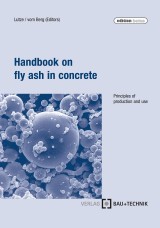Details
Handbook on fly ash in concrete
Principles of production and useedition beton 2. Aufl.
|
47,99 € |
|
| Verlag: | Verlag Bau+Technik |
| Format: | EPUB |
| Veröffentl.: | 20.03.2013 |
| ISBN/EAN: | 9783764005375 |
| Sprache: | englisch |
| Anzahl Seiten: | 146 |
Dieses eBook enthält ein Wasserzeichen.
Beschreibungen
When used as an addition and binder component, fly ash has become an indispensable construction material for many concrete applications. The conditions produced in power stations when firing fine pulverized coal result in the formation of a reactive, flour-fine, pozzolanic mineral material from the accompanying rock in the coal. Owing to its specific characteristics it has a positive impact on the properties of fresh and hardened concrete and facilitates cost-effective production of high-grade, durable concretes.
The authors of this handbook have combined the latest discoveries from the field of research with practical experience of the use and effects of fly ash in concrete. This handbook provides the necessary information and makes interesting suggestions for selective use of fly ash in concrete.
The authors of this handbook have combined the latest discoveries from the field of research with practical experience of the use and effects of fly ash in concrete. This handbook provides the necessary information and makes interesting suggestions for selective use of fly ash in concrete.
1 Basic principles
1.1 Definition
1.2 Historical development
1.3 Raw materials, production and quality control of fly ash
1.3.1 Raw materials
1.3.2 Production
1.3.3 Monitoring and certification
1.4 Material properties of fly ash
1.4.1 Mineral and chemical composition
1.4.2 Physical parameters
1.4.3 Environmental and health compatibility
2 Effect of fly ash in concrete
2.1 Physical effect
2.2 Chemical effect
2.3 Properties of the pore structure
2.4 Properties of the contact zone between aggregate and hardened cement paste
3 Use of fly ash in concrete
3.1 General
3.2 Fly ash as a concrete addition
3.2.1 Requirements
3.2.2 Concrete conforming to DIN EN 206-1/DIN 1045-2
3.2.3 Concrete for concrete products
3.3 Production of concrete containing fly ash
3.3.1 Transporting, storing and conveying
3.3.2 Metering and mixing
3.3.3 Placing and processing
3.3.4 Curing and removal of formwork
3.4 Fly ash as a main constituent of cement
4 Properties of concrete containing fly ash
4.1 Fresh concrete
4.1.1 Water demand
4.1.2 Workability
4.1.3 Early stiffening
4.1.4 Setting
4.2 Hardened concrete
4.2.1 Evolution of heat of hydration and tendency to cracking
4.2.2 Strength
4.2.3 Deformation
4.2.4 Durability
4.2.5 Environmental and health compatibility
5 Special concretes and types of construction
5.1 High strength concrete
5.2 Liquid-impermeable concrete
5.3 Self compacting concrete (SCC)
5.4 Concrete with high sulfate resistance
5.5 Concrete with increased resistance to acid attack
5.6 Concrete with high resistance to freeze-thaw with and without de-icing agent
5.6.1 Concrete with high freeze-thaw resistance
5.6.2 Concrete with high resistance to freeze-thaw with de-icing agent
5.7 Sand-rich concrete
5.8 Fibre-reinforced concrete
5.9 Fair-faced concrete
5.10 Mass concrete
5.11 Dry building materials
5.12 Sprayed concrete
5.13 Recycled concrete / concrete with recycled aggregate
5.14 Concrete for road surfacing
5.15 Roller compacted concrete
5.16 Underwater concrete
5.17 Bored pile concrete / diaphragm wall concrete
5.18 Lightweight concrete
5.19 Precast concrete elements
5.20 Concrete products
5.21 Textile reinforced concrete
Appendix
1 Codes of practice
2 Guidelines
3 Standards and legal regulations
4 Members of the European Coal Combustion Products Association
1.1 Definition
1.2 Historical development
1.3 Raw materials, production and quality control of fly ash
1.3.1 Raw materials
1.3.2 Production
1.3.3 Monitoring and certification
1.4 Material properties of fly ash
1.4.1 Mineral and chemical composition
1.4.2 Physical parameters
1.4.3 Environmental and health compatibility
2 Effect of fly ash in concrete
2.1 Physical effect
2.2 Chemical effect
2.3 Properties of the pore structure
2.4 Properties of the contact zone between aggregate and hardened cement paste
3 Use of fly ash in concrete
3.1 General
3.2 Fly ash as a concrete addition
3.2.1 Requirements
3.2.2 Concrete conforming to DIN EN 206-1/DIN 1045-2
3.2.3 Concrete for concrete products
3.3 Production of concrete containing fly ash
3.3.1 Transporting, storing and conveying
3.3.2 Metering and mixing
3.3.3 Placing and processing
3.3.4 Curing and removal of formwork
3.4 Fly ash as a main constituent of cement
4 Properties of concrete containing fly ash
4.1 Fresh concrete
4.1.1 Water demand
4.1.2 Workability
4.1.3 Early stiffening
4.1.4 Setting
4.2 Hardened concrete
4.2.1 Evolution of heat of hydration and tendency to cracking
4.2.2 Strength
4.2.3 Deformation
4.2.4 Durability
4.2.5 Environmental and health compatibility
5 Special concretes and types of construction
5.1 High strength concrete
5.2 Liquid-impermeable concrete
5.3 Self compacting concrete (SCC)
5.4 Concrete with high sulfate resistance
5.5 Concrete with increased resistance to acid attack
5.6 Concrete with high resistance to freeze-thaw with and without de-icing agent
5.6.1 Concrete with high freeze-thaw resistance
5.6.2 Concrete with high resistance to freeze-thaw with de-icing agent
5.7 Sand-rich concrete
5.8 Fibre-reinforced concrete
5.9 Fair-faced concrete
5.10 Mass concrete
5.11 Dry building materials
5.12 Sprayed concrete
5.13 Recycled concrete / concrete with recycled aggregate
5.14 Concrete for road surfacing
5.15 Roller compacted concrete
5.16 Underwater concrete
5.17 Bored pile concrete / diaphragm wall concrete
5.18 Lightweight concrete
5.19 Precast concrete elements
5.20 Concrete products
5.21 Textile reinforced concrete
Appendix
1 Codes of practice
2 Guidelines
3 Standards and legal regulations
4 Members of the European Coal Combustion Products Association



















